In Vermont, during the arrival of warblers in spring and summer, yellow birds are a common sight, but in winter, the American Goldfinch stands out as the most frequently spotted yellow bird in the area.
To aid in identifying the yellow birds you encounter in Vermont, this comprehensive guide offers images, identification details, audio recordings of their songs, as well as information on their migration patterns.
The majority of yellow birds found in Vermont belong to the warbler, oriole, or tanager families, and occasionally, the female birds differ significantly in appearance from their male counterparts.
With the abundance of information provided in this guide, identifying yellow birds in Vermont will become a much simpler task. The list of yellow birds is arranged in order of their frequency of sightings in Vermont during the spring and summer months (May and June), based on ebird checklists.
Yellow birds present in Vermont throughout the year include the American Goldfinch and Evening Grosbeak. During the summer, you may also come across the Common Yellowthroat, Cedar Waxwing, Yellow-rumped Warbler, Yellow Warbler, American Redstart, Black-throated Green Warbler, Baltimore Oriole, Scarlet Tanager, Pine Warbler, Magnolia Warbler, Nashville Warbler, Palm Warbler, Canada Warbler, Eastern Meadowlark, Yellow-throated Vireo, Blue-winged Warbler, Prairie Warbler, and Orchard Oriole.
During migration, keep an eye out for the Cape May Warbler, Wilson’s Warbler, and Orange-crowned Warbler.
Continue reading this guide to successfully identify the yellow birds you’ve observed.
Here are 23 Yellow Birds in Vermont:
1. American Goldfinch
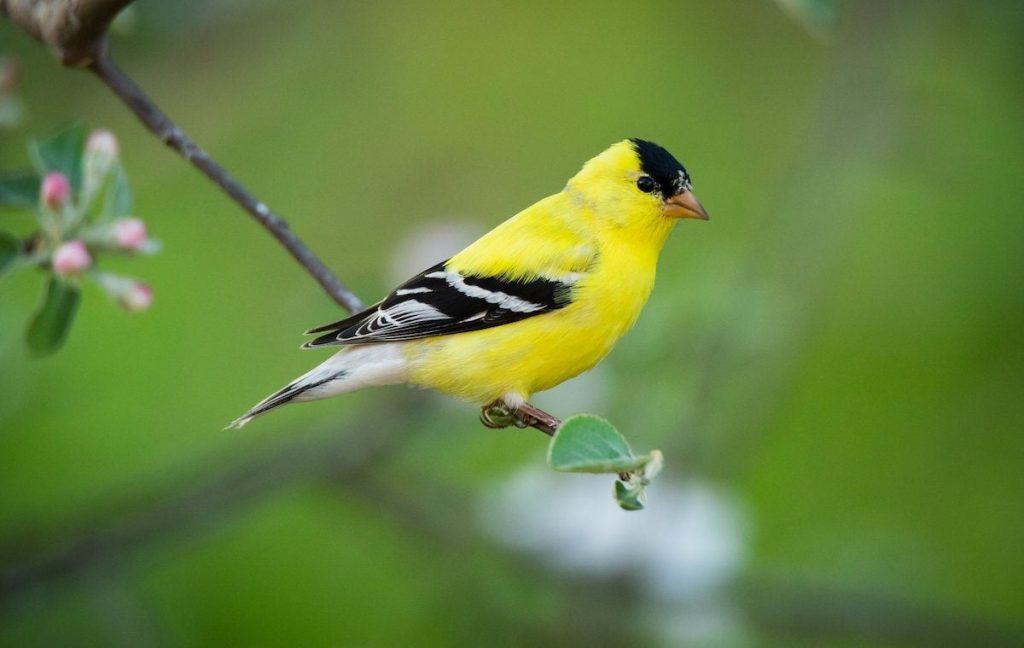
The American Goldfinch is a year-round resident of Vermont, with their population increasing during the breeding season. Birdwatchers have reported sightings of this bird in 46% of summer checklists and 27% of winter checklists in the state.
These goldfinches are well-known for their vibrant yellow and black plumage in the spring, particularly the males. During winter, both males and females exhibit a duller brown appearance.
Spinus tristis
Length: 4.3-5.1 inches (11-13 cm)
Weight: 0.4-0.7 ounces (11-20 g)
Wingspan: 7.5-8.7 inches (19-22 cm)
American Goldfinches can be found throughout most of North America and usually reside there all year. However, those that breed in Canada and the Midwest migrate to southern US states during the winter.
These birds are commonly found in weedy fields, overgrown areas, suburbs, parks, and backyards, where they forage for seeds from sunflower, thistle, and aster plants.
American Goldfinch Song:
American Goldfinches typically construct their nests in shrubs using rootlets and plant materials interwoven with spider webs. The nests are firmly secured to branches. The female goldfinches lay up to seven eggs, which take around two weeks to hatch. The young birds leave the nest after approximately two to two and a half weeks.
To attract American Goldfinches to your backyard, consider planting thistles and milkweed. They are known to visit various bird feeders, with a preference for sunflower and nyjer seeds.
Fun Fact: Due to their strictly vegetarian diet, cowbirds are unable to persuade American Goldfinches to raise their young, resulting in the death of cowbird chicks within a few days.
2. Common Yellowthroat
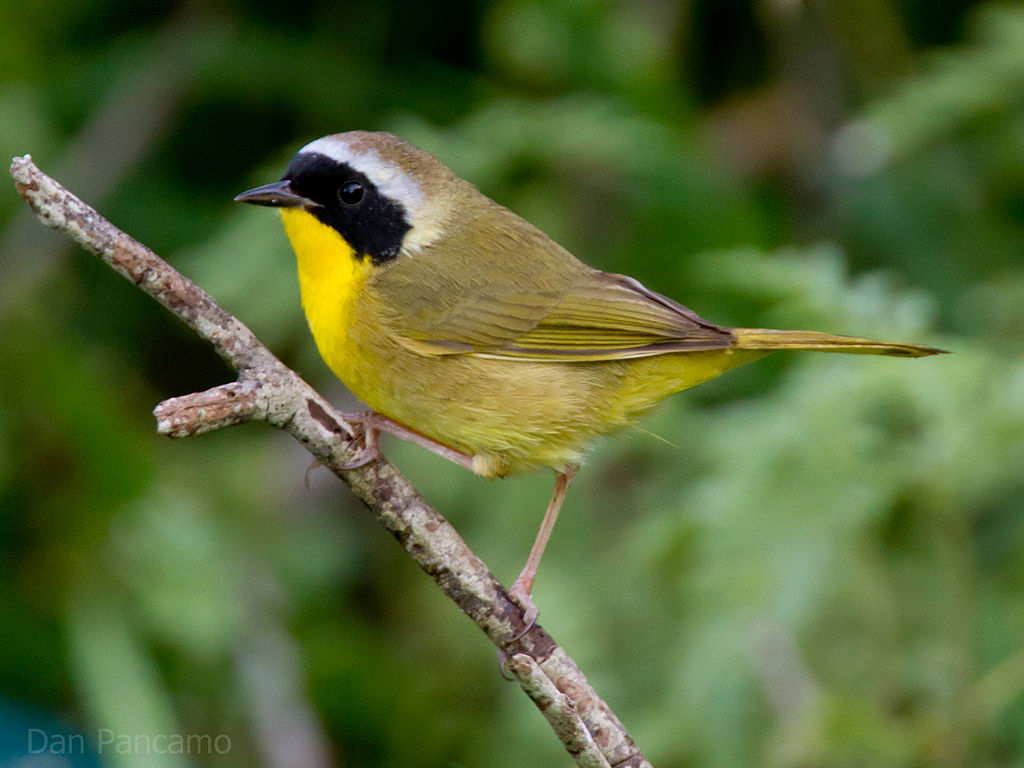
Common Yellowthroats can be found in Vermont during the breeding season from April to October, and some may remain until January. Approximately 37% of summer checklists include sightings of these birds.
These small songbirds have brownish backs and vibrant yellow undersides, with long tails. The males sport black masks across their faces. The intensity of their yellow plumage may vary depending on geographic location, with some appearing more olive-toned underneath.
Geothlypis trichas
Length: 4.3-5.1 inches (11-13 cm)
Weight: 0.3-0.3 ounces (9-10 g)
Wingspan: 5.9-7.5 inches (15-19 cm)
Common Yellowthroats breed across most of North America, excluding Alaska and northern Canada. Some individuals remain along the Gulf Coast and Pacific Southwest throughout the year, while others migrate south for the winter.
These birds are commonly found in marshy or wetland areas and brushy fields, where they reside amidst thick, tangled vegetation.
Common Yellowthroat Song:
Credit: Paul Marvin, XC629250. Available at www.xeno-canto.org/629250.
Female Common Yellowthroats construct their nests near the ground in marshy locations, supported by reeds. The nests are primarily composed of grass and sedges, forming a platform with leaves and grass. They lay up to six eggs, which hatch after approximately twelve days. The young birds leave the nest within a similar timeframe.
To attract Common Yellowthroats to larger backyards, ensure the presence of dense vegetation and native plants that attract insects.
Fun Fact: Male Common Yellowthroats interpret the black mask of their counterparts as a male identifier and engage in aggressive behavior toward decoy birds with masks. However, they do not react aggressively when the decoy lacks a mask.
3. Cedar Waxwing
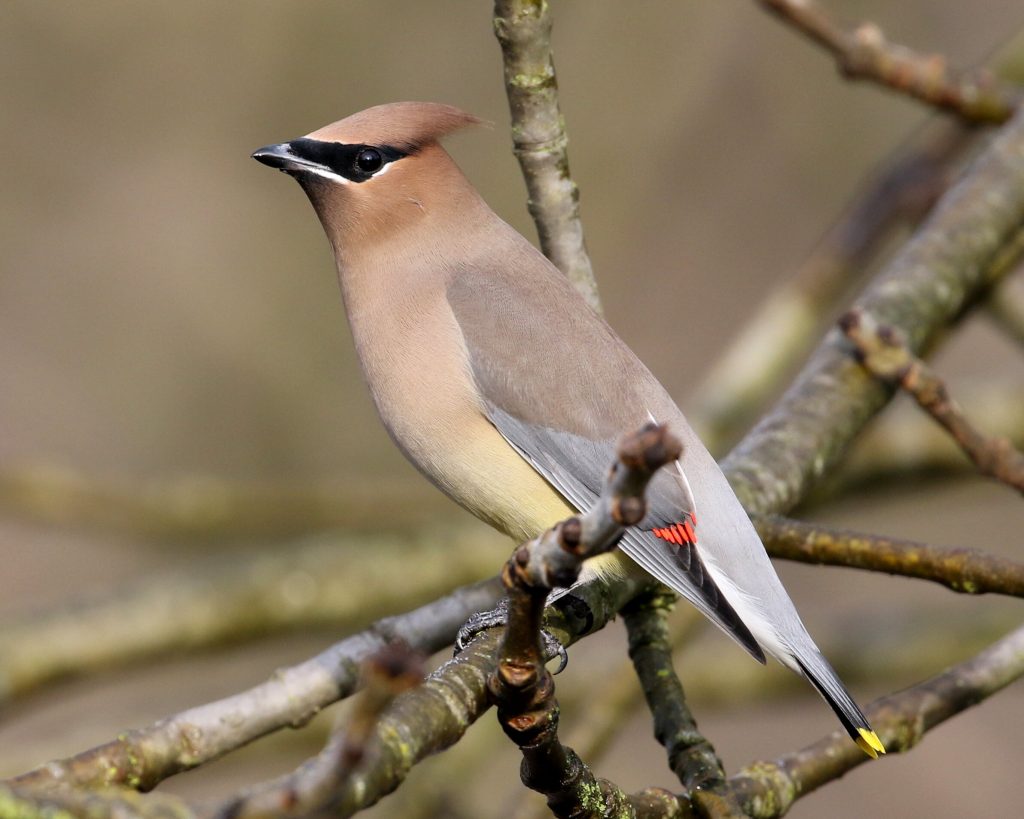
Cedar Waxwings can be seen throughout southern Vermont all year, but their presence is more common in the northern regions during the breeding season from June to mid-October. These birds are recorded in 17% of summer checklists and 3% of winter checklists in the state.
Cedar Waxwings are elegant and sociable creatures, characterized by pale brown heads, chests, and crests that transition to gray on their backs, wings, and tails. Their bellies display a pale yellow shade, with bright yellow tips on their tails. They feature a slender black mask over their eyes and vibrant red wingtips.
Bombycilla cedrorum
Length: 5.5-6.7 inches (14-17 cm)
Weight: 1.1 ounces (32 g)
Wingspan: 8.7-11.8 inches (22-30 cm)
Breeding populations of Cedar Waxwings are found in Canada, after which they migrate to the southern United States, Mexico, and Central America for winter. Some individuals remain year-round in northern US states.
Cedar Waxwings can be observed in berry bushes, woodlands, grasslands, urban areas, and along streams. Their diet mainly consists of fruit, but they also consume insects during the summer.
Cedar Waxwing Call:
Credit: Peter Ward and Ken Hall, XC512254. Available at www.xeno-canto.org/512254.
Female Cedar Waxwings construct their nests using twigs, grass, hair, and plant materials, lining them with pine needles and soft grass. The nests typically contain up to six eggs, which hatch after approximately twelve days. The young birds leave the nest within around sixteen days.
To attract Cedar Waxwings to your backyard, consider planting native trees and shrubs that produce small fruits such as serviceberry, dogwood, juniper, winterberry, and hawthorn. You can also try offering fruit on platform feeders.
Fun Fact: Cedar Waxw
ings engage in a unique behavior of passing gifts between potential mates during courtship.
4. Yellow-rumped Warbler
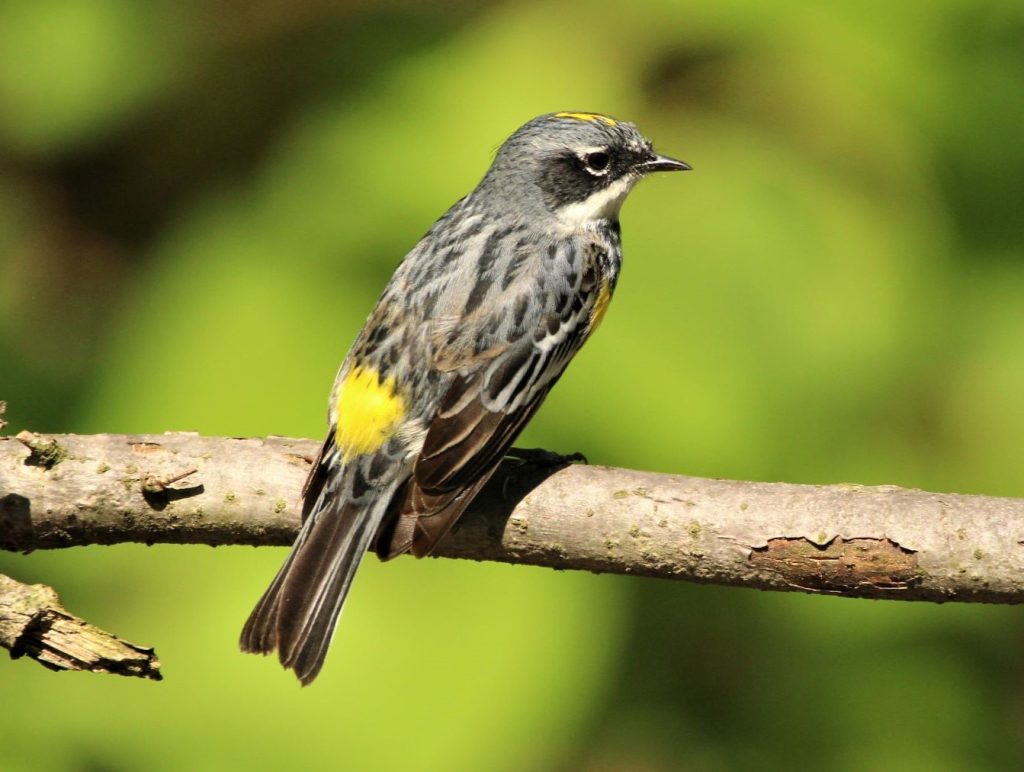
Yellow-rumped Warblers breed in Vermont and experience increased numbers during their migration in May and October. They are spotted in 17% of summer checklists and up to 39% of checklists during migration.
These warblers exhibit gray plumage with splashes of yellow on their faces, sides, and rumps, accompanied by white patches on their wings.
Females may display a slightly browner appearance, while winter birds feature paler brown feathers with bright yellow rumps and sides that transition back to yellow and gray in the spring.
Setophaga coronata
Length: 4.7-5.5 inches (12-14 cm)
Weight: 0.4-0.5 ounces (12-13 g)
Wingspan: 7.5-9.1 inches (19-23 cm)
Yellow-rumped Warblers primarily breed in Canada, the Rockies, and the Appalachian Mountains.
During migration, they can be seen in the Midwest before wintering in southern and southwestern US states, the Pacific Coast, Mexico, and Central America.
Yellow-rumped Warblers are commonly found in coniferous forests, especially during the breeding season. In winter, they occupy open areas with fruiting shrubs. Their diet primarily consists of insects during the summer, while they rely more on fruit consumption during migration and winter, including bayberry and wax myrtle.
Yellow-rumped Warbler Song:
Credit: Christopher McPherson, XC602699. Available at www.xeno-canto.org/602699.
Female Yellow-rumped Warblers construct their nests in conifer trees using twigs, pine needles, and grass, lining them with soft grass, moss, and hair. They typically lay up to six eggs, which hatch after around two weeks. The young birds leave the nest within an additional two weeks.
To attract Yellow-rumped Warblers to your backyard, provide sunflower seeds, suet, raisins, and peanut butter.
Fun Fact: Yellow-rumped Warblers form large flocks, numbering in the thousands, during the winter season, and they can display aggression towards other species that come too close.
5. Yellow Warbler
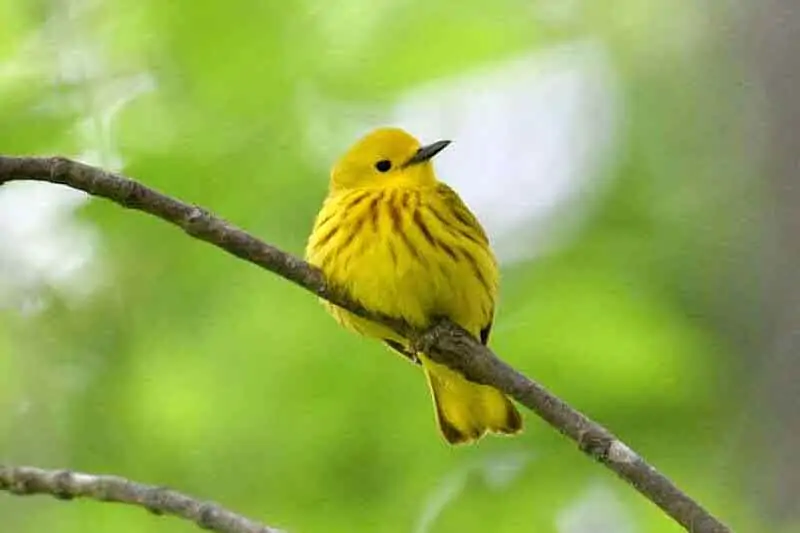
During the breeding season, Yellow Warblers can be observed in Vermont, with sightings documented in 24% of summer checklists. They arrive in April and commence migration in October.
Yellow Warblers are small, brightly colored birds adorned with yellow-green backs. The males feature chestnut streaks on their breasts, while females and juveniles exhibit a less vibrant appearance compared to males.
Setophaga petechia
Length: 4.7-5.1 inches (12-13 cm)
Weight: 0.3-0.4 ounces (9-11 g)
Wingspan: 6.3-7.9 inches (16-20 cm)
Yellow Warblers embark on long-distance migrations, breeding in Canada and the United States (excluding southeastern states) before journeying to Central and South America for winter. However, they can be seen during migration in southeastern US states.
These warblers primarily inhabit areas along streams, wetlands, thickets, and field edges, where they actively forage for insects, including caterpillars, midges, beetles, bugs, and wasps.
Yellow Warbler Song:
Credit: Richard E. Webster, XC662546. Available at www.xeno-canto.org/662546.
Female Yellow Warblers construct their nests in small trees or shrubs using bark, grass, and plant materials interwoven and secured with spider webs to form cup-shaped structures. The nests are then lined with softer materials
like hair, feathers, and plant down. They lay up to seven eggs, which hatch after around twelve days. The young birds leave the nest within ten days.
To attract Yellow Warblers to your backyard, consider offering suet, oranges, peanut butter, and plants that produce berries. Additionally, planting native plants that attract insects without using pesticides or maintaining excessive tidiness is beneficial. Installing birdbaths with fountains near secluded planting areas provides additional protection.
Fun Fact: Yellow Warblers exhibit a unique nesting behavior when cowbirds lay eggs in their nests. If detected, the Yellow Warblers build a new nest on top of the old one, repeating this process up to six times.
6. American Redstart Female
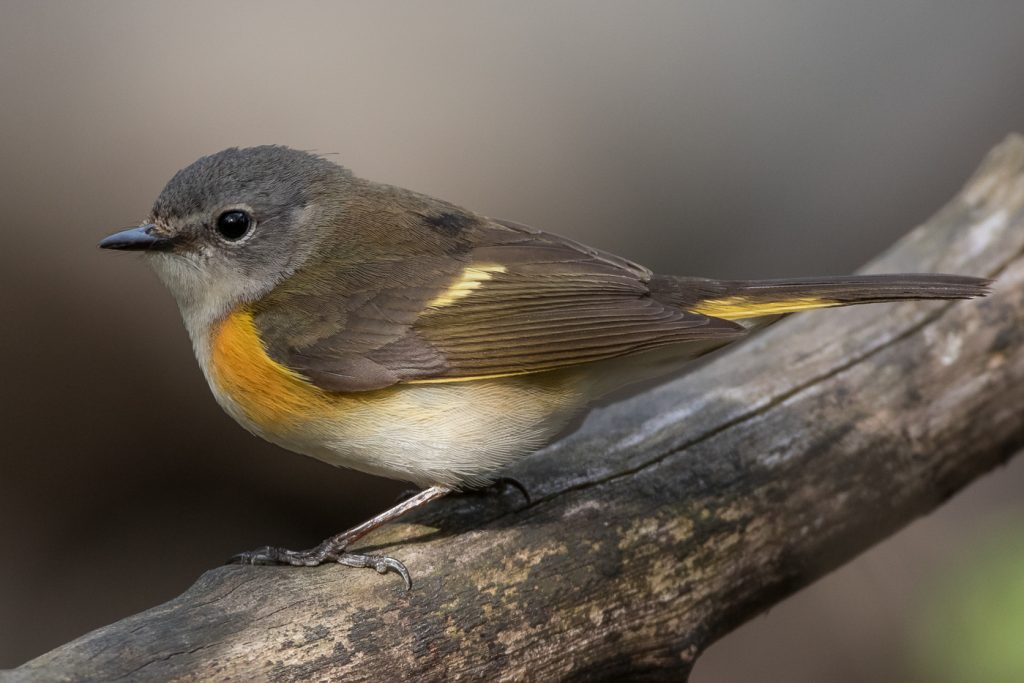
American Redstarts breed in Vermont and can be observed in the area from April to October. They are recorded in 19% of summer checklists.
Male American Redstarts possess predominantly black plumage with vibrant orange patches and a white belly. Females, on the other hand, display an olive-gray appearance instead of black, with numerous yellow patches.
Setophaga ruticilla
Length: 4.3-5.1 inches (11-13 cm)
Weight: 0.2-0.3 ounces (6-9 g)
Wingspan: 6.3-7.5 inches (16-19 cm)
American Redstarts breed in the eastern United States and Canada, extending to northwestern US states. They may also be observed during migration in central and western US states.
These birds can be found in deciduous woodlands, backyards, and thickets, where they feed on berries such as serviceberry and magnolia.
American Redstart Song:
Christopher McPherson, XC522368. Available at www.xeno-canto.org/522368.
Nests of American Redstarts are typically situated close to the trunk of trees or large shrubs. They are constructed using bark, grass, and other plant materials. Female redstarts lay up to five eggs, which hatch after nearly two weeks. The young birds take approximately one to two weeks to leave the nest.
To attract American Redstarts to your backyard, consider planting berry-producing plants such as magnolia and serviceberry.
Fun Fact: American Redstart parents selectively feed certain chicks, rather than providing food to all of them at once.
7. Black-throated Green Warbler

During the breeding season, Black-throated Green Warblers can be spotted in Vermont from April to mid-November. They are recorded in 14% of summer checklists.
Black-throated Green Warblers are small yellow songbirds with yellow faces and heads, and olive-yellow backs. They feature black streaks on their sides and wings, with a whitish underside. Males have large black patches on their throats, while the size of these patches is smaller in females and juveniles.
Setophaga virens
Length: 4.3-4.7 inches (11-12 cm)
Weight: 0.3-0.4 ounces (7-11 g)
Wingspan: 6.7-7.9 inches (17-20 cm)
Black-throated Green Warblers migrate extensively over the eastern United States to their breeding grounds in northeastern states and Canada. They winter in Mexico, northern South America, and the Caribbean.
These warblers can be found high up in forests, foraging on insects. Their black throat serves as a distinguishing feature that sets them apart from other small yellow birds.
Black-throated Green Warblers Song:
Credit: Paul Driver, XC187636. Available at www.xeno-canto.org/187636.
Nests of Black-throated Green Warblers are built in small trees, close to the trunk. They are constructed from twigs, bark, pine needles, and grass, woven together with spider webs. The nests are lined with animal hair, moss, and feathers. Female warblers lay approximately four eggs, which hatch after around twelve days. The young birds leave the nest within two weeks.
To attract Black-throated Green Warblers to your backyard, maintain mature trees in the area.
Fun Fact: Male Black-throated Green Warblers can sing over 400 times in an hour and perform a unique “gloating” flight after chasing away rivals.
8. Baltimore Oriole Female

Baltimore Orioles breed in Vermont and are primarily observed from May to mid-September. However, a few individuals may remain until December. They are recorded in 16% of summer checklists.
Baltimore Orioles are vibrant signs of spring in the eastern regions of North America. Adult males exhibit bright orange and black plumage with white wing bars.
Females, on the other hand, display yellowish undersides and heads, with gray-brown wings and brownish-yellow backs. They are roughly the size of a Robin but possess a more slender physique. Baltimore Orioles belong to the blackbird family.
Icterus galbula
Length: 6.7-7.5 inches (17-19 cm)
Weight: 1.1-1.4 ounces (30-40 g)
Wingspan: 9.1-11.8 inches (23-30 cm)
Baltimore Orioles breed in eastern and central states of the United States, including central-southern Canadian provinces and the southern border with the US.
During winter, they migrate to Florida, Central America, and the Caribbean, departing as early as July.
Baltimore Orioles can be found in open woodlands, along riverbanks, forest edges, and even parks and backyards. They primarily feed on insects such as beetles, crickets, grasshoppers, spiders, and snails. Additionally, they consume a wide variety of fruits, although they can cause damage to crops such as raspberries, mulberries, cherries, bananas, and oranges.
Baltimore Oriole sounds: The flute-like calls of Baltimore Orioles are a delight of the spring season. They also produce chattering and sharp alarm calls.
Christopher McPherson, XC690956. Available at www.xeno-canto.org/690956.
To attract Baltimore Orioles to your backyard, try offering oranges cut in half on a platform feeder or hanging them from trees. Oriole feeders filled with sugar water can also be effective. Planting fruiting plants and nectar-rich flowers like raspberries, crab apples, and trumpet vines can further entice them.
Fun Fact: Baltimore Orioles build intricate hanging bag-like nests woven from various fibers.
9. Scarlet Tanager Female
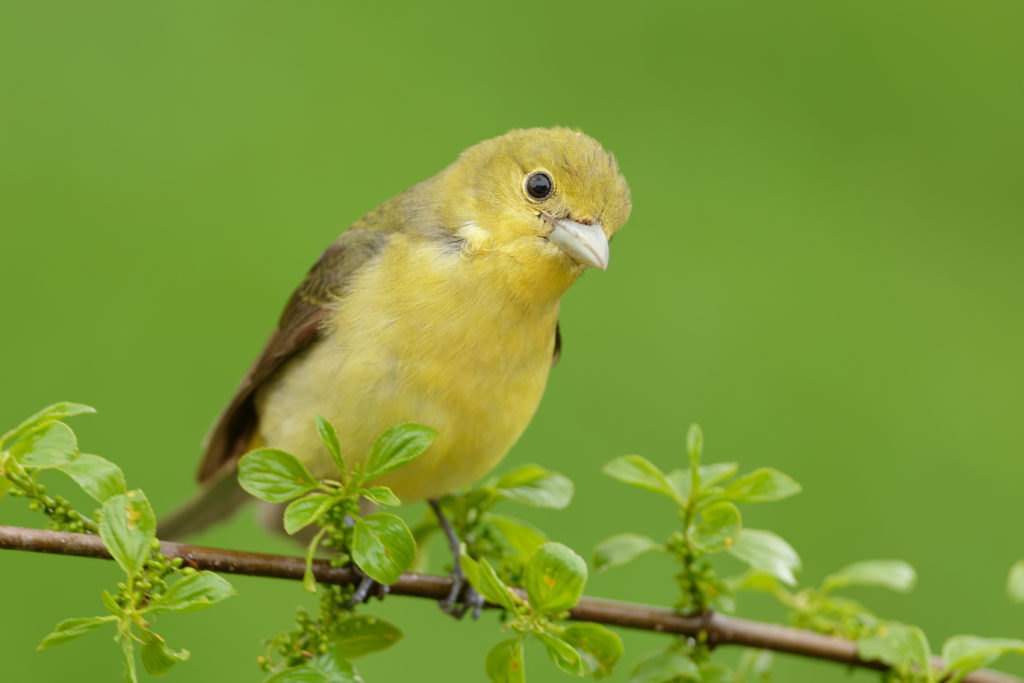
Scarlet Tanagers are present during the summer season in Vermont and are recorded in 9% of checklists during this time. They can be observed from April and commence their migration in October.
Female Scarlet Tanagers display yellow plumage with darker wings and tails, similar to the appearance of molting males.
Male Scarlet Tanagers, on the other hand, showcase striking red feathers with black wings and tails. They possess thick bills and relatively short tails.
Piranga olivacea
Length: 6.3-6.7 inches (16-17 cm)
Weight: 0.8-1.3 ounces (23-38 g)
Wingspan: 9.8-11.4 inches (25-29 cm)
During the summer, Scarlet Tanagers breed in eastern forests before migrating to western South America. They can also be observed during migration in southeastern US states.
Scarlet Tanagers prefer to remain high up in the forest canopy, making them challenging to spot. However, their red plumage may occasionally catch your eye as they walk along branches in search of insects.
Scarlet Tanager Song:
Credit: Christopher McPherson, XC599850. Available at www.xeno-canto.org/599850.
Nests of Scarlet Tanagers are constructed within only about four days, using loosely woven twigs, grass, and plant material. The interior is lined with soft grass, pine needles, and other gentle materials. Female tanagers lay around four eggs, which hatch after nearly two weeks. The young birds fledge within an additional week or two.
To attract Scarlet Tanagers, consider planting berry-producing trees such as blackberries, raspberries, huckleberries, juneberries, serviceberries, mulberries, strawberries, and chokeberries.
Fun Fact: Male Scarlet Tanagers engage in singing battles, sometimes escalating to actual fights with rival males.
10. Pine Warbler
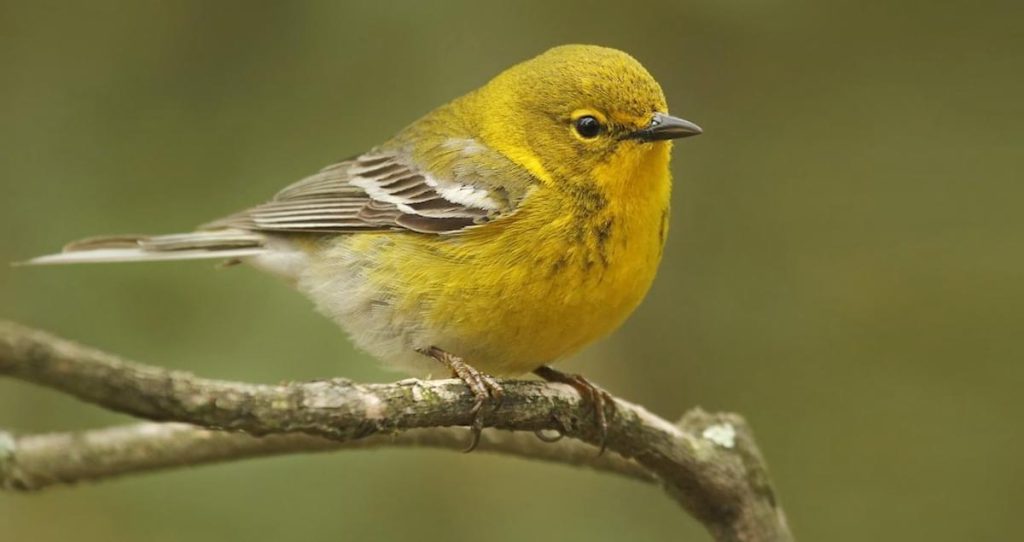
Pine Warblers are recorded in 6% of summer checklists in Vermont and are predominantly observed from April to mid-October.
These warblers exhibit small, plump bodies with yellow plumage and olive backs. They possess white lower bellies and gray wingbars. Females may appear slightly browner and exhibit more white on the belly.
Setophaga pinus
Length: 5.1-5.5 inches (13-14 cm)
Weight: 0.3-0.5 ounces (9-15 g)
Wingspan: 7.5-9.1 inches (19-23 cm)
Pine Warblers breed in northeastern US states before migrating to southeastern US states. Some individuals remain year-round in the southeastern regions.
These warblers are often found in pine forests, as their name suggests, often residing high up in the trees. They primarily feed on caterpillars, beetles, spiders, and other insects. In colder weather, they may also consume fruit and seeds.
Pine Warbler Song:
Credit: Christopher McPherson, XC602052. Available at www.xeno-canto.org/602052.
Nests of Pine Warblers are typically built in pine trees using twigs, bark, pine needles, and grass. These materials are woven together and secured with spider silk. The nests are lined with feathers and animal hair. Female warblers lay up to five eggs, which hatch after approximately two weeks. The young birds leave the nest within an additional ten days.
To attract Pine Warblers to your backyard, consider providing tube feeders and platform feeders with millet, cracked corn, sunflower seeds, peanut hearts, and suet. Additionally, planting native trees and shrubs that produce berries, such as bayberry, grape, sumac, and Virginia creeper, can be enticing.
Fun Fact: Pine Warblers are among the few warbler species that primarily consume seeds, making them more likely to visit backyard feeders.
11. Magnolia Warbler
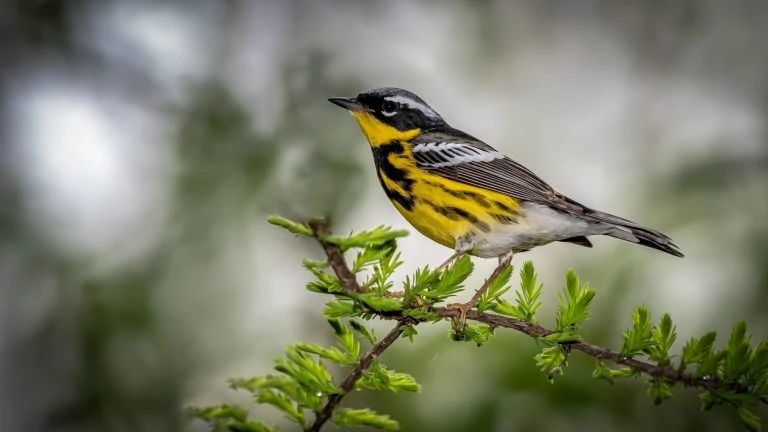
Magnolia Warblers are frequent visitors to Vermont during the breeding season. They can be spotted from May to mid-September and are recorded in 12% of summer checklists.
These warblers display striking black streaks on their yellow chests, along with black masks and white undertails. Their backs are primarily dark gray or black, and they have white wing bars.
Setophaga magnolia
Length: 4.3-5.1 inches (11-13 cm)
Weight: 0.3-0.4 ounces (8-12 g)
Wingspan: 7.1-8.3 inches (18-21 cm)
Magnolia Warblers breed in the northern regions of North America, including parts of Canada and the northeastern United States. During migration, they pass through the eastern and central United States.
These warblers inhabit various forested areas, including mixed forests and coniferous forests. They primarily feed on insects, such as beetles, caterpillars, and spiders.
Magnolia Warbler Song:
Credit: Andrew Spencer, XC654890. Available at www.xeno-canto.org/654890.
Nests of Magnolia Warblers are usually built on the ground, hidden under dense vegetation or at the base of shrubs. They are constructed using grass, leaves, and other plant materials, lined with fine grasses, hair, and feathers. Female warblers lay around four to five eggs, which hatch after about two weeks. The young birds leave the nest within ten to twelve days.
To attract Magnolia Warblers to your backyard, maintain a diverse forested habitat with a mix of trees, shrubs, and understory vegetation.
Fun Fact: The name “Magnolia Warbler” comes from the mistaken belief that the birds were discovered near magnolia trees, although they are not typically associated with those trees.
12. Nashville Warbler
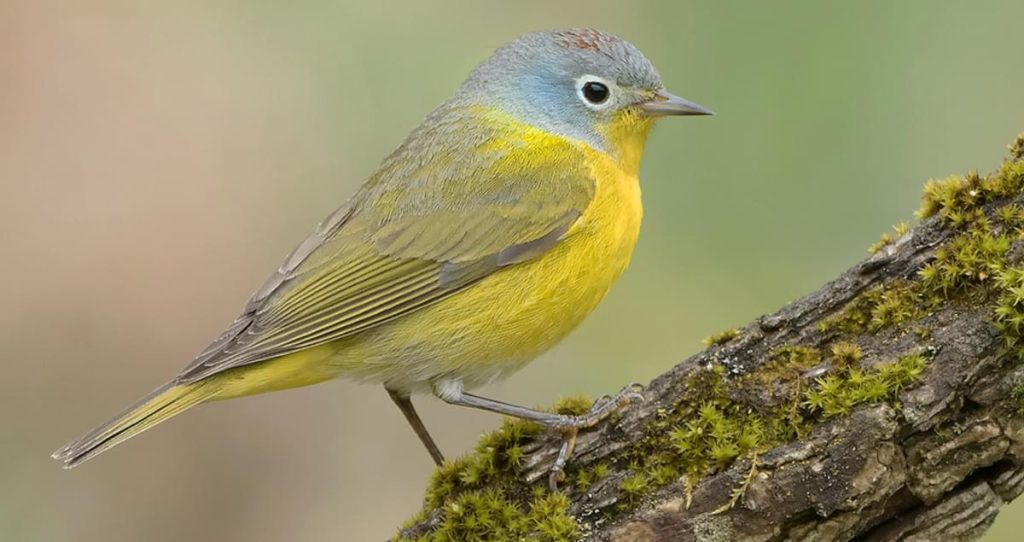
Nashville Warblers are migratory birds that breed in Vermont during the summer. They are usually seen from May to September and are recorded in 8% of summer checklists.
These warblers have yellow underparts, olive-green backs, and a gray hood that extends to their nape. They also have a white eyering and yellow patches on their wings.
Leiothlypis ruficapilla
Length: 4.3-4.7 inches (11-12 cm)
Weight: 0.3-0.4 ounces (8-11 g)
Wingspan: 6.7-7.5 inches (17-19 cm)
Nashville Warblers breed in the northern parts of North America, including parts of Canada and the northeastern United States. During migration, they pass through central and eastern US states.
These warblers inhabit a variety of forested areas, including mixed forests, deciduous forests, and coniferous forests. They primarily feed on insects, such as spiders, caterpillars, and beetles.
Nashville Warbler Song:
Credit: Ross Gallardy, XC670913. Available at www.xeno-canto.org/670913.
Nests of Nashville Warblers are usually built on or near the ground, concealed under vegetation or leaf litter. They are constructed using grass, moss, and other plant materials, lined with fine grasses, feathers, and hair. Female warblers lay around four to five eggs, which hatch after approximately two weeks. The young birds leave the nest within ten to twelve days.
To attract Nashville Warblers to your backyard, create a diverse habitat with a mix of trees, shrubs, and ground cover.
Fun Fact: The Nashville Warbler was named after Nashville, Tennessee, where the first specimen was collected.
13. Palm Warbler
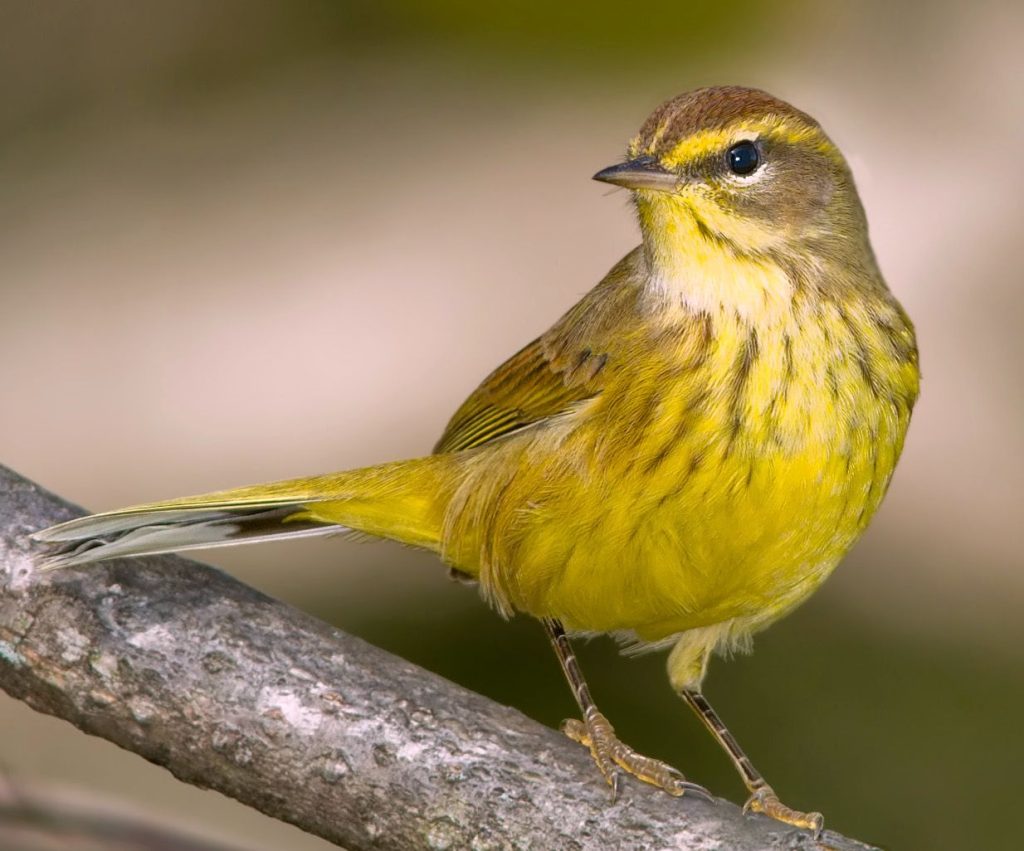
Palm Warblers can be seen in Vermont during migration seasons, particularly in spring and fall. They are recorded in 12% of spring and 14% of fall checklists.
These warblers display a mix of brown, yellow, and gray plumage. They have a rusty cap, yellow undertail, and often wag their tails, giving them a distinctive appearance.
Setophaga palmarum
Length: 4.7-5.1 inches (12-13 cm)
Weight: 0.3-0.4 ounces (9-11 g)
Wingspan: 7.9-8.7 inches (20-22 cm)
Palm Warblers breed in the northern regions of North America, including parts of Canada and Alaska. During migration, they travel through the eastern and central United States.
These warblers inhabit various habitats, including open woodlands, forest edges, and marshes. They primarily feed on insects, such as spiders, beetles, and caterpillars, but also consume berries and seeds.
Palm Warbler Song:
Credit: Greg Irving, XC654890. Available at www.xeno-canto.org/654890.
Nests of Palm Warblers are usually built on or near the ground, hidden under vegetation or leaf litter. They are constructed using grass, moss, and other plant materials, lined with feathers and hair. Female warblers lay around four to five eggs, which hatch after approximately two weeks. The young birds leave the nest within ten to twelve days.
To attract Palm Warblers to your backyard during migration, provide a mixture of open spaces and vegetative cover. Water sources and areas with low-growing plants can be particularly attractive to them.
Fun Fact: Palm Warblers are known for their distinctive tail-wagging behavior, which sets them apart from other warbler species.
14. Canada Warbler
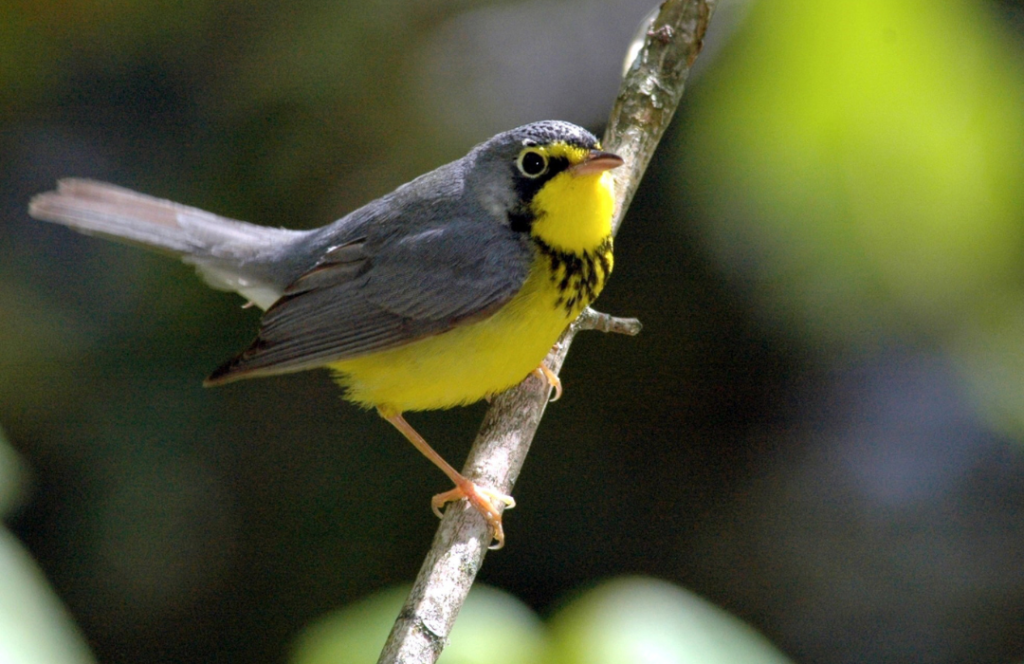
Canada Warblers are migratory birds that breed in Vermont during the summer. They are typically seen from May to August and are recorded in 9% of summer checklists.
These warblers have striking yellow underparts with a necklace-like pattern of black streaks on their throat and upper chest. They have gray-blue upperparts, a gray head, and a prominent white eyering.
Cardellina canadensis
Length: 4.3-5.1 inches (11-13 cm)
Weight: 0.3-0.4 ounces (9-11 g)
Wingspan: 6.7-7.5 inches (17-19 cm)
Canada Warblers breed in the northern parts of North America, including parts of Canada and the northeastern United States. During migration, they pass through the eastern United States.
These warblers inhabit dense deciduous and mixed forests, particularly those near water bodies. They primarily feed on insects, such as beetles, caterpillars, and spiders.
Canada Warbler Song:
Credit: Ian Davies, XC402703. Available at www.xeno-canto.org/402703.
Nests of Canada Warblers are usually built on or near the ground, concealed under vegetation or leaf litter. They are constructed using grass, moss, and other plant materials, lined with fine grasses, feathers, and hair. Female warblers lay around three to five eggs, which hatch after approximately two weeks. The young birds leave the nest within ten to twelve days.
To attract Canada Warblers to your backyard during migration, create a habitat with a mix of trees, shrubs, and understory vegetation near a water source.
Fun Fact: Canada Warblers are known for their unique “zeet” call, which helps distinguish them from other warbler species.
15. Eastern Meadowlark
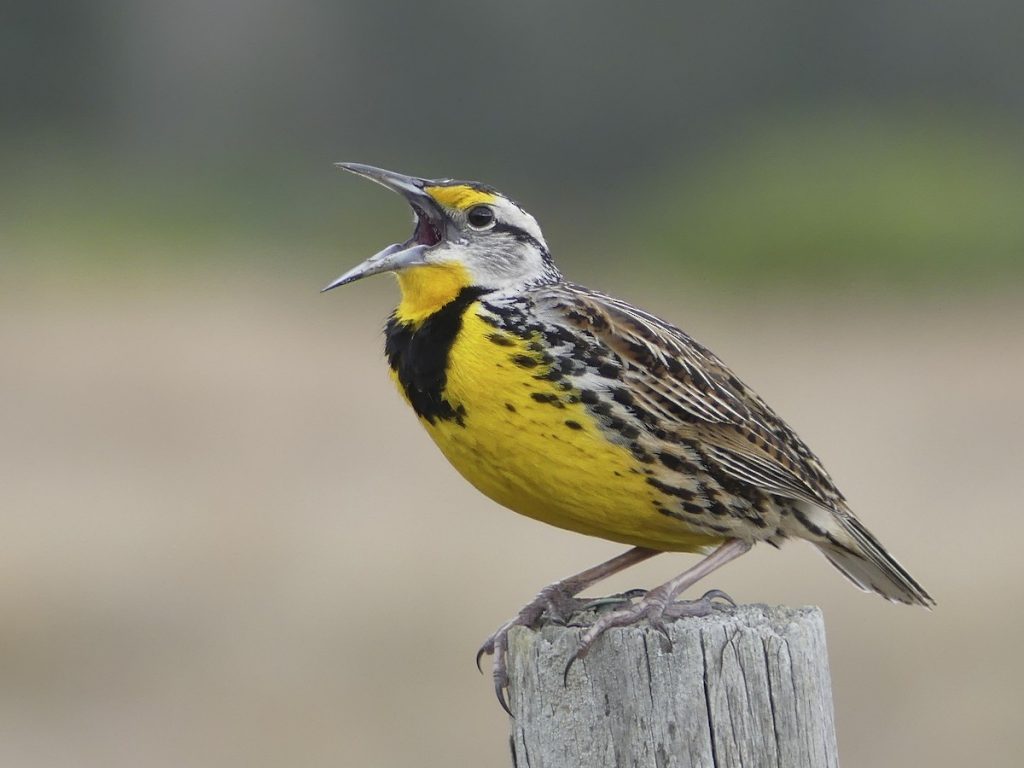
Eastern Meadowlarks are year-round residents in Vermont. They can be seen throughout the year and are recorded in 16% of checklists.
These birds have a vibrant yellow breast with a black “V” pattern extending from the throat to the lower belly. They have brownish upperparts and a long, pointed bill.
Sturnella magna
Length: 7.9-10.6 inches (20-27 cm)
Weight: 4.6-8.1 ounces (130-230 g)
Wingspan: 15.0-16.9 inches (38-43 cm)
Eastern Meadowlarks inhabit open grasslands, fields, and meadows with scattered trees or shrubs. They primarily feed on insects, such as grasshoppers, crickets, beetles, and caterpillars, but also consume seeds and berries.
Eastern Meadowlark Song:
Credit: Mike Nelson, XC642964. Available at www.xeno-canto.org/642964.
Nests of Eastern Meadowlarks are built on the ground, concealed in grass or vegetation. They are constructed using grass stems and other plant materials, lined with finer grasses and hair. Female meadowlarks lay around three to seven eggs, which hatch after approximately two weeks. The young birds leave the nest within ten to twelve days.
To attract Eastern Meadowlarks to your backyard, provide open grassy areas or meadows with minimal disturbance.
Fun Fact: Eastern Meadowlarks are known for their distinctive melodious song, which resembles a flute-like whistle.
16. Yellow-throated Vireo
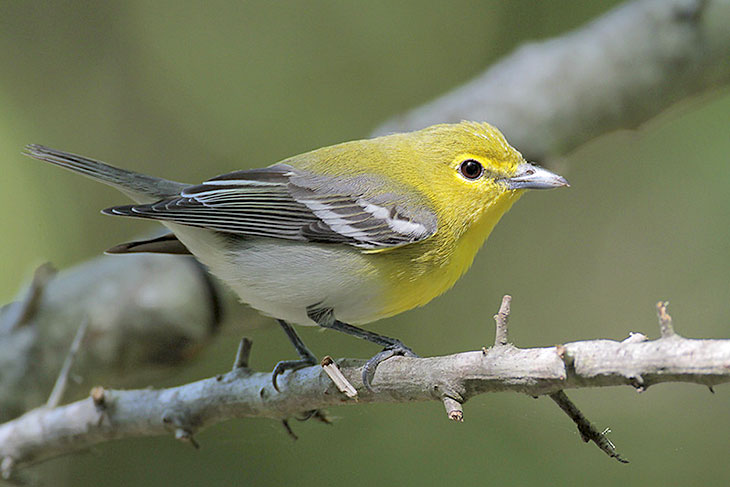
Yellow-throated Vireos are migratory birds that breed in Vermont during the summer. They can be seen from May to August and are recorded in 5% of summer checklists.
These vireos have a yellow throat and underparts, olive-green upperparts, and a gray crown. They also have distinctive white spectacles around their eyes.
Vireo flavifrons
Length: 5.9-6.7 inches (15-17 cm)
Weight: 0.5-0.7 ounces (14-20 g)
Wingspan: 9.8-10.6 inches (25-27 cm)
Yellow-throated Vireos breed in the eastern parts of North America, including parts of Canada and the northeastern United States. During migration, they travel through the eastern United States.
These vireos inhabit deciduous and mixed forests, particularly those near water bodies. They primarily feed on insects, such as caterpillars, beetles, and spiders.
Yellow-throated Vireo Song:
Credit: Andrew Spencer, XC482720. Available at www.xeno-canto.org/482720.
Nests of Yellow-throated Vireos are usually built in the fork of a tree, using bark, twigs, grass, and other plant materials, lined with fine grasses, hair, and feathers. Female vireos lay around three to five eggs, which hatch after approximately two weeks. The young birds leave the nest within ten to twelve days.
To attract Yellow-throated Vireos to your backyard during migration, provide a habitat with a mix of tall trees and understory vegetation near a water source.
Fun Fact: Yellow-throated Vireos are known for their persistent singing, which can continue throughout the day.
17. Blue-winged Warbler
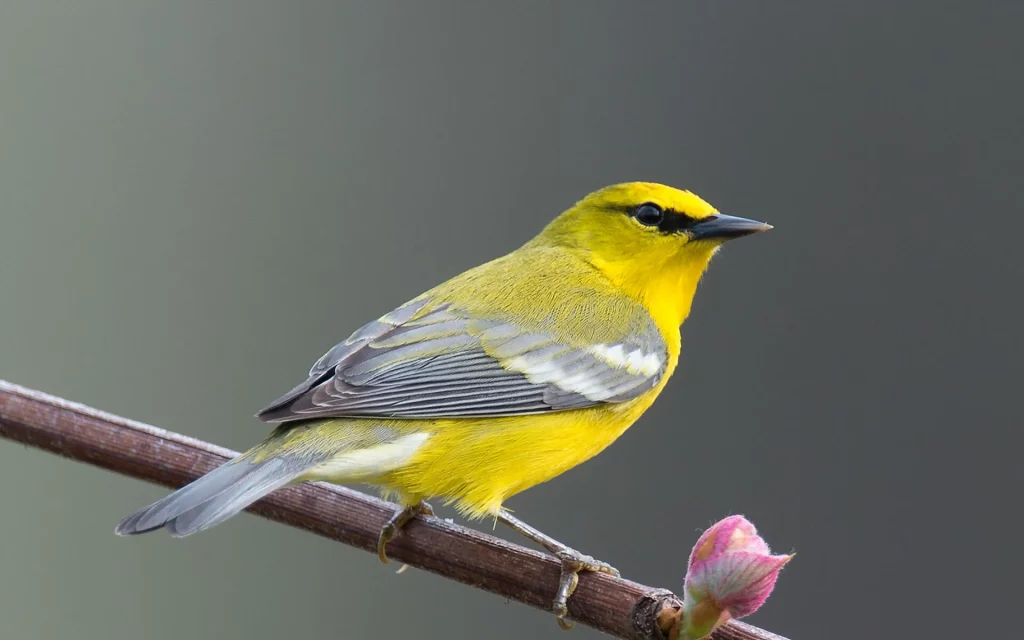
Blue-winged Warblers are migratory birds that breed in Vermont during the summer. They are usually seen from May to August and are recorded in 4% of summer checklists.
These warblers have a yellow head and underparts, with blue-gray wings and a white belly. They have a distinctive black eye line extending through their eyes.
Vermivora cyanoptera
Length: 4.7-5.1 inches (12-13 cm)
Weight: 0.3-0.4 ounces (9-11 g)
Wingspan: 6.7-7.5 inches (17-19 cm)
Blue-winged Warblers breed in the eastern parts of North America, including parts of the northeastern United States. During migration, they pass through the eastern and central United States.
These warblers inhabit open habitats with shrubby areas, such as old fields, forest edges, and brushy areas. They primarily feed on insects, such as caterpillars, beetles, and spiders.
Blue-winged Warbler Song:
Credit: Ian Davies, XC370661. Available at www.xeno-canto.org/370661.
Nests of Blue-winged Warblers are usually built on or near the ground, concealed under vegetation or leaf litter. They are constructed using grass, plant fibers, and other plant materials, lined with fine grasses and hair. Female warblers lay around four to six eggs, which hatch after approximately two weeks. The young birds leave the nest within ten to twelve days.
To attract Blue-winged Warblers to your backyard during migration, provide shrubby areas with open spaces for foraging.
Fun Fact: Blue-winged Warblers often hybridize with Golden-winged Warblers, resulting in a hybrid species known as the “Brewster’s Warbler” or “Lawrence’s Warbler.”
18. Prairie Warbler
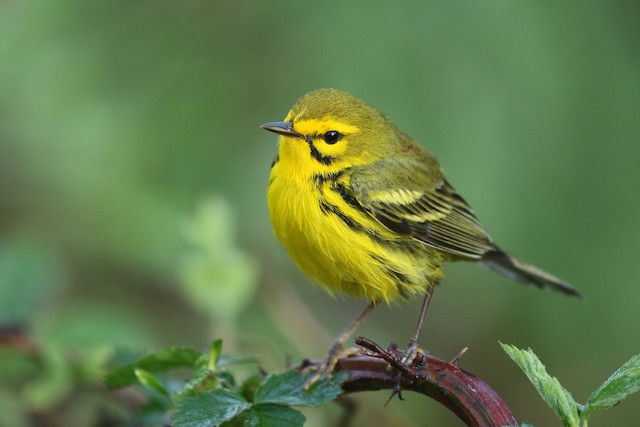
Prairie Warblers are migratory birds that breed in Vermont during the summer. They can be seen from May to August and are recorded in 5% of summer checklists.
These warblers have bright yellow underparts, olive-green upperparts, and a rusty cap. Males have distinctive black streaks on their sides and a black cheek patch.
Setophaga discolor
Length: 4.3-4.7 inches (11-12 cm)
Weight: 0.3-0.4 ounces (9-11 g)
Wingspan: 6.3-7.1 inches (16-18 cm)
Prairie Warblers breed in the eastern parts of North America, including parts of the northeastern United States. During migration, they pass through the eastern and central United States.
These warblers inhabit open habitats with shrubby areas, such as old fields, grasslands, and shrublands. They primarily feed on insects, such as beetles, caterpillars, and spiders.
Prairie Warbler Song:
Credit: Frank Lambert, XC670912. Available at www.xeno-canto.org/670912.
Nests of Prairie Warblers are usually built near the ground, concealed under vegetation or leaf litter. They are constructed using grass, plant fibers, and other plant materials, lined with fine grasses and hair. Female warblers lay around three to five eggs, which hatch after approximately two weeks. The young birds leave the nest within ten to twelve days.
To attract Prairie Warblers to your backyard during migration, provide open habitats with shrubby areas and patches of grass.
Fun Fact: Prairie Warblers are often associated with pine trees and open habitats, despite the absence of prairies in their typical breeding range.
19. Orchard Oriole
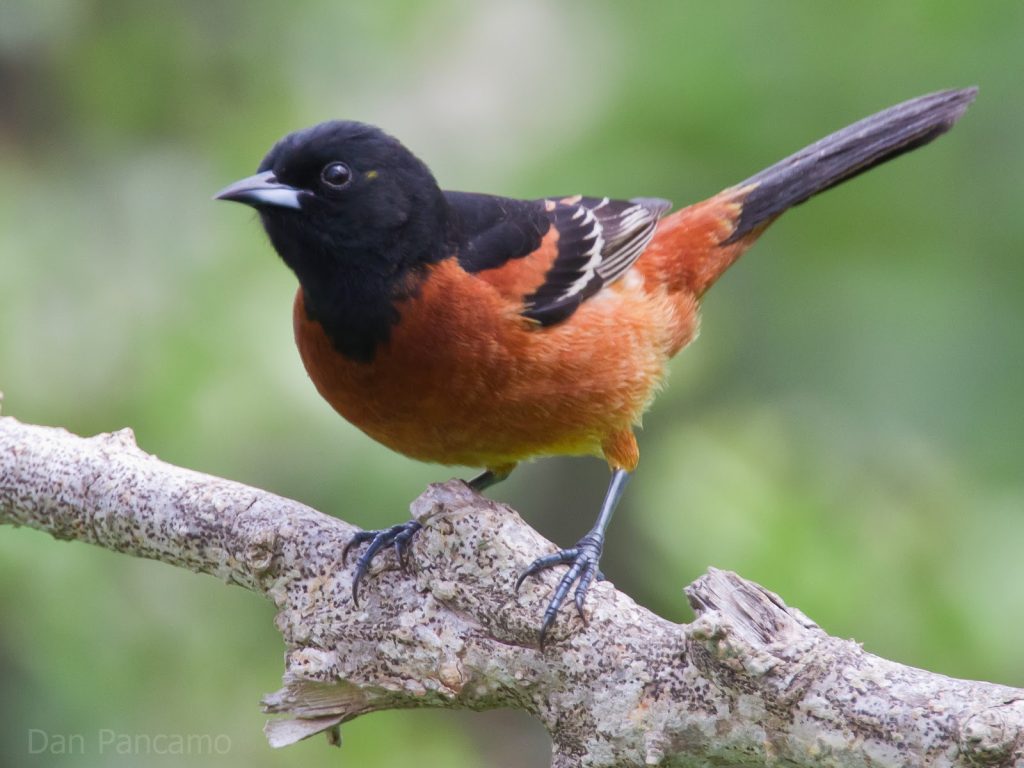
Orchard Orioles spend the breeding season in Vermont and can be spotted from May to August. They are recorded in 7% of summer checklists.
Male Orchard Orioles have a brilliant flame-orange plumage with black wings and tail. Females and immature birds have olive-green upperparts and yellowish underparts.
Icterus spurius
Length: 6.3-7.1 inches (16-18 cm)
Weight: 0.7-1.0 ounces (20-28 g)
Wingspan: 9.8-10.6 inches (25-27 cm)
Orchard Orioles breed in the eastern parts of North America, including parts of the northeastern United States. During migration, they travel through the eastern and central United States.
These orioles inhabit open woodlands, orchards, and forest edges. They primarily feed on insects, such as caterpillars, beetles, and grasshoppers, but also consume nectar and fruit.
Orchard Oriole Song:
Credit: Eric DeFonso, XC579281. Available at www.xeno-canto.org/579281.
Nests of Orchard Orioles are usually built on the tips of slender tree branches, using grass, plant fibers, and other plant materials, lined with fine grasses, hair, and feathers. Female orioles lay around three to six eggs, which hatch after approximately two weeks. The young birds leave the nest within twelve to fourteen days.
To attract Orchard Orioles to your backyard during the breeding season, provide trees with open spaces for nesting and a source of nectar or fruit.
Fun Fact: Orchard Orioles are known for their delicate, flute-like song, which is considered melodious and pleasant to the ear.
20. Eastern Towhee

Eastern Towhees are year-round residents in Vermont and can be seen throughout the year. They are recorded in 30% of checklists.
These birds have a black head, back, and tail, with rufous sides and a white belly. Males have a distinctive red eye, while females have a brown eye.
Pipilo erythrophthalmus
Length: 7.1-8.3 inches (18-21 cm)
Weight: 1.1-1.5 ounces (31-42 g)
Wingspan: 7.9-11.0 inches (20-28 cm)
Eastern Towhees inhabit dense shrubby areas, forest edges, and overgrown fields. They primarily feed on insects, spiders, and seeds, but also scratch through leaf litter in search of food.
Eastern Towhee Song:
Credit: Andrew Spencer, XC366571. Available at www.xeno-canto.org/366571.
Nests of Eastern Towhees are built on or near the ground, concealed in dense vegetation or leaf litter. They are constructed using leaves, bark, and twigs, lined with fine grasses and rootlets. Female towhees lay around three to five eggs, which hatch after approximately two weeks. The young birds leave the nest within ten to twelve days.
To attract Eastern Towhees to your backyard, provide dense shrubby areas, leaf litter, and bird feeders with seeds.
Fun Fact: Eastern Towhees are known for their distinct call, which sounds like “drink-your-tea!”
21. Brown Thrasher

Brown Thrashers are year-round residents in Vermont and can be seen throughout the year. They are recorded in 29% of checklists.
These birds have a reddish-brown upper body with streaks and a white belly. They have a long, curved bill and bright yellow eyes.
Toxostoma rufum
Length: 9.0-11.4 inches (23-29 cm)
Weight: 2.3-3.1 ounces (66-88 g)
Wingspan: 11.8-12.6 inches (30-32 cm)
Brown Thrashers inhabit shrubby areas, overgrown fields, and forest edges. They primarily feed on insects, spiders, and a variety of berries and fruits.
Brown Thrasher Song:
Credit: Ian Davies, XC384913. Available at www.xeno-canto.org/384913.
Nests of Brown Thrashers are built in dense shrubs or low trees, using twigs, leaves, and grasses, lined with finer materials such as rootlets and hair. Female thrashers lay around three to five eggs, which hatch after approximately two weeks. The young birds leave the nest within ten to twelve days.
To attract Brown Thrashers to your backyard, provide shrubby areas, dense vegetation, and bird feeders with a variety of food.
Fun Fact: Brown Thrashers are skilled mimics and can imitate the songs of other birds, as well as sounds such as car alarms and ringing phones.
22. Hermit Thrush

Hermit Thrushes are migratory birds that breed in Vermont during the summer. They can be seen from May to October and are recorded in 33% of summer checklists.
These thrushes have a reddish-brown upper body with a contrasting white belly. They have a spotted breast and a distinctive reddish tail.
Catharus guttatus
Length: 6.3-7.1 inches (16-18 cm)
Weight: 0.7-1.1 ounces (20-31 g)
Wingspan: 9.8-11.4 inches (25-29 cm)
Hermit Thrushes breed in the northern regions of North America, including parts of Canada and the northeastern United States. During migration, they travel through the eastern and central United States.
These thrushes inhabit a variety of forested areas, including deciduous and coniferous forests. They primarily feed on insects, spiders, and berries.
Hermit Thrush Song:
Credit: Bob McGuire, XC646179. Available at www.xeno-canto.org/646179.
Nests of Hermit Thrushes are built on the ground, concealed under vegetation or leaf litter. They are constructed using twigs, leaves, and grasses, lined with fine grasses, hair, and feathers. Female thrushes lay around three to four eggs, which hatch after approximately two weeks. The young birds leave the nest within ten to twelve days.
To attract Hermit Thrushes to your backyard during migration, provide a mix of deciduous and coniferous trees, shrubs, and leaf litter.
Fun Fact: The Hermit Thrush has a beautiful and haunting song, often described as ethereal and flute-like.
23. Veery
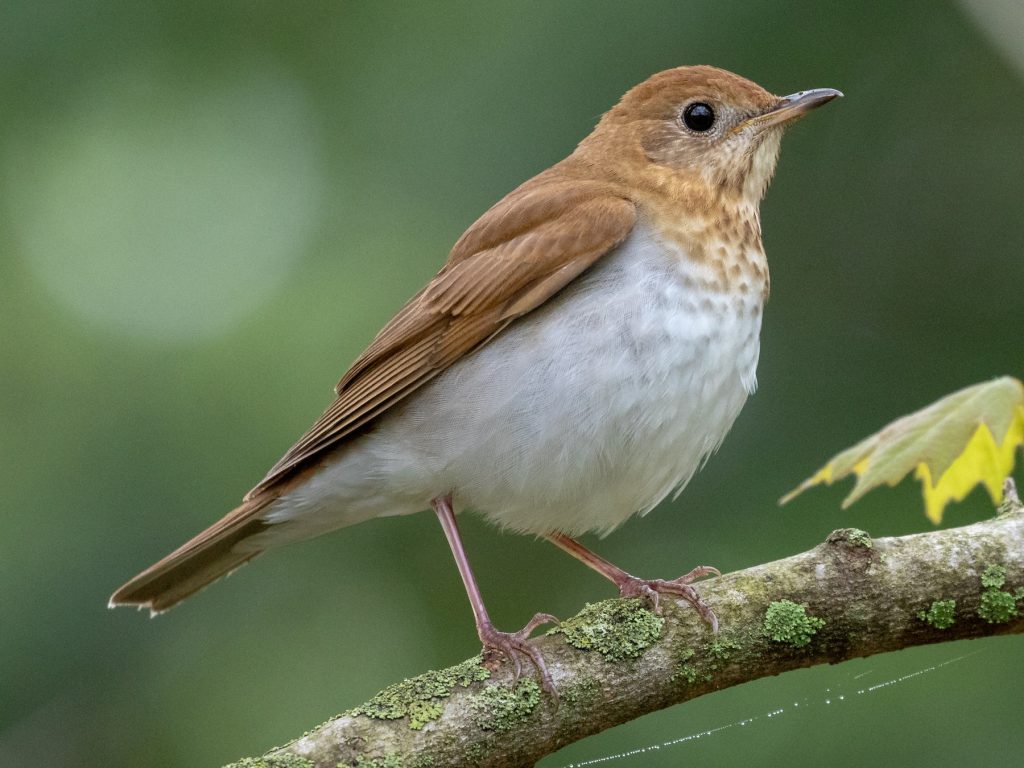
Veeries are migratory birds that breed in Vermont during the summer. They can be seen from May to September and are recorded in 19% of summer checklists.
These thrushes have a cinnamon-brown upper body with a creamy white belly. They have dark spots on their upperparts and a distinctive cream-colored eye ring.
Catharus fuscescens
Length: 6.7-7.5 inches (17-19 cm)
Weight: 0.8-1.1 ounces (22-32 g)
Wingspan: 11.4-12.2 inches (29-31 cm)
Veeries breed in the northern regions of North America, including parts of Canada and the northeastern United States. During migration, they travel through the eastern and central United States.
These thrushes inhabit a variety of forested areas, including deciduous and mixed forests. They primarily feed on insects, spiders, and berries.
Veery Song:
Credit: Andrew Spencer, XC652234. Available at www.xeno-canto.org/652234.
Nests of Veeries are built on or near the ground, concealed under vegetation or leaf litter. They are constructed using twigs, leaves, and grasses, lined with fine grasses and rootlets. Female veeries lay around three to four eggs, which hatch after approximately two weeks. The young birds leave the nest within ten to twelve days.
To attract Veeries to your backyard during migration, provide a habitat with a mix of trees, shrubs, and leaf litter.
Fun Fact: The Veery is known for its beautiful and melodic song, often described as a cascading series of flute-like notes.
